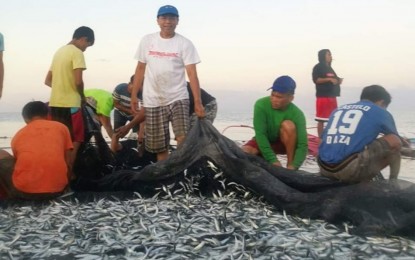
ABUNDANT FISH. Fisherfolk of Tibiao, Antique catch one ton of round scad in Malabor village on Feb. 15, 2020. The province of Antique gets to showcase its rich marine biodiversity when it hosts the 1st International Sports Fishing Tournament in May. (Photo courtesy of Flord Calawag)
ILOILO CITY – The province of Antique gets to showcase its rich marine biodiversity when it hosts the 1st International Sports Fishing Tournament in May.
“Sports fishing is another tourism product that we are promoting. When they go to Antique, they can experience fishing onboard a fishing boat,” Flord Nicson Calawag, president of the Antique Eco-Tourism Association (AETA), said in a phone interview on Friday.
The tournament, set on May 2-3, has two categories: amateur and professional anglers and registered municipal fisherfolk. Participants may use traditional trolling and bait fishing.
Calawag said the participants will experience 12 hours of fishing from the coastal waters of Tibiao municipality to as far as Seco Island, 21 km. away from the town’s shore.
The anglers with the heaviest fish catch will bring home the PHP50,000 prize while the first and second runners-up will get PHP30,000 and PHP20,000, respectively.
For the registered fisherfolk category, winners will receive PHP20,000, PHP15,000, and PHP10,000 for the champion, first and second runners-up, respectively.
Calawag said they were inspired to push for the tournament as the supply of fish has become abundant in their coastal waters following the strict enforcement of fishery laws by the provincial government, the Bureau of Fisheries and Aquatic Resources (BFAR), and the Philippine Coast Guard (PCG).
“This is very unique. We have participants from (the) US (United States) and other Asean (Association Southeast Asian Nations) countries,” he said, adding that they also have preventive measures for international participants amid the threat of the coronavirus disease 2019 (Covid-19).
Meanwhile, Calawag, who is a licensed fishery technologist, described Tibiao as a “tuna highway”.
He said migratory fish have a highway from the Philippines to Japan to California and the Pacific.
In the Philippines, there are sub-highways, one of which is the Cuyo East Passage (between Palawan and Antique) where Tibiao is located.
Aside from the abundant fish, whale sharks, Mobula rays, and Ocean sunfish were also trapped during the “lambaklad” fishing in Tibiao. They were, however, released back to the waters.
“Because of the awareness that some of these species are endangered, and through the campaign of BFAR, fisherfolk, brokers, (and) vendors are aware that it is prohibited to catch endangered species,” Calawag said.
“Lambaklad”, he said, is one of the largest stationary fish traps in the country. It is derived from the Kinaray-a language “lambat” net and “baklad” (corral).
“When there is a presence of endangered species, it is an indicator of (healthy) biodiversity. Meaning, the ecosystem is healthy,” Calawag said, adding that Antique is blessed with abundant resources -- from the mountains to the sea.
Meanwhile, BFAR 6 (Western Visayas) Director Remia A. Aparri said the presence of endangered species means a balanced ecosystem, otherwise, only small fish would be left behind.
“They prey (on) small fish. They are the higher forms of animals in the marine ecosystem,” Aparri said.
What is needed, she said, is to ensure that the public is educated on the importance of the species and responsible fishing for sustainable harvest in the coastal area. (PNA)
